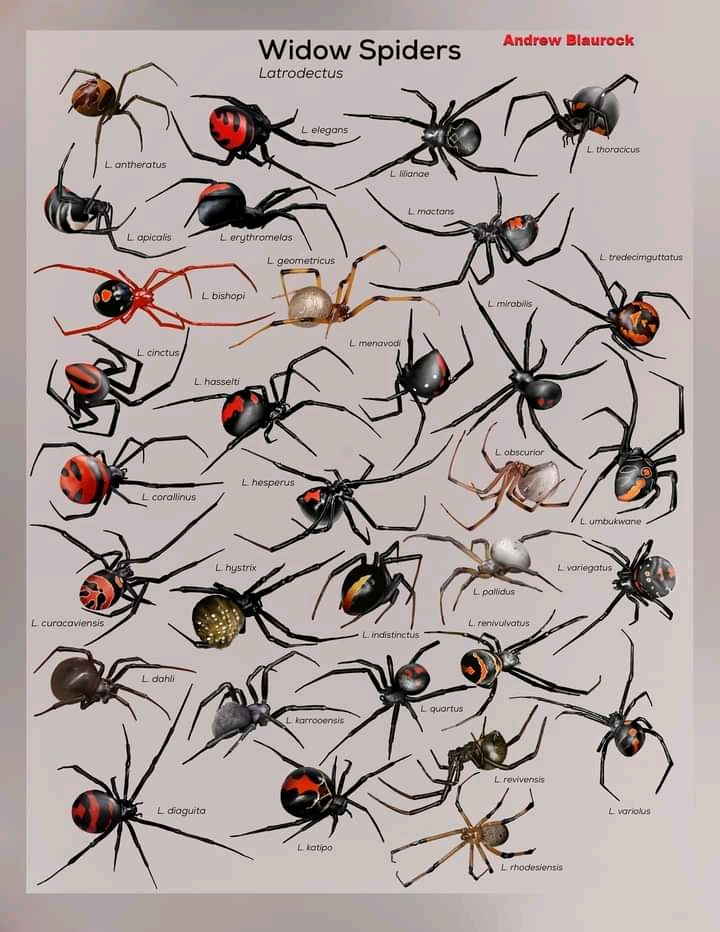Brown Widow Spider (Egypt): Captures and Eats Snakes
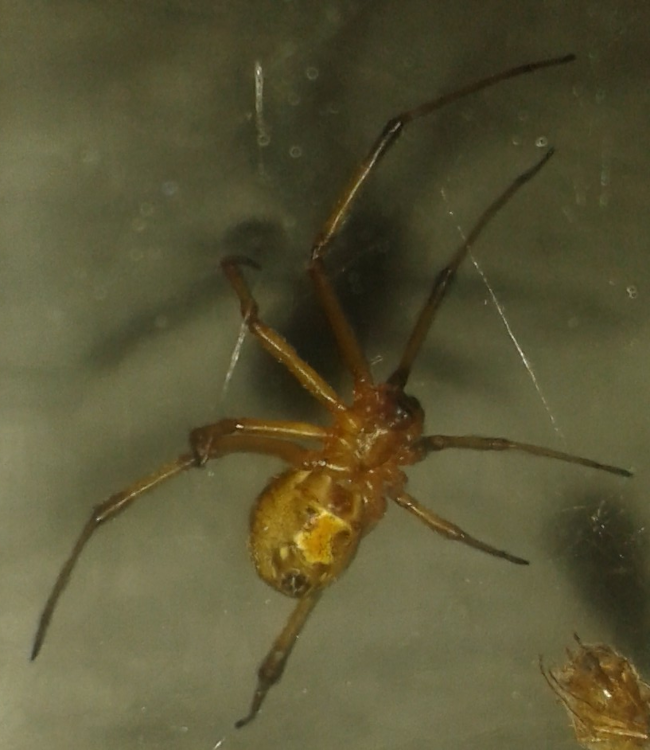
Image credit: Kagemni. Used under CC 4.0 License.
This blog was prompted by articles about snakes and spiders that I read on STEMsocial last week. I wondered, Do snakes eat spiders? And if they do, which snakes actively hunt spiders for food? I discovered that snakes do indeed eat spiders. In fact, a snake will eat anything that can be characterized as 'meat'. Snakes are obligate carnivores, and therefore must eat meat in order to survive.
Corn Snake, Adult
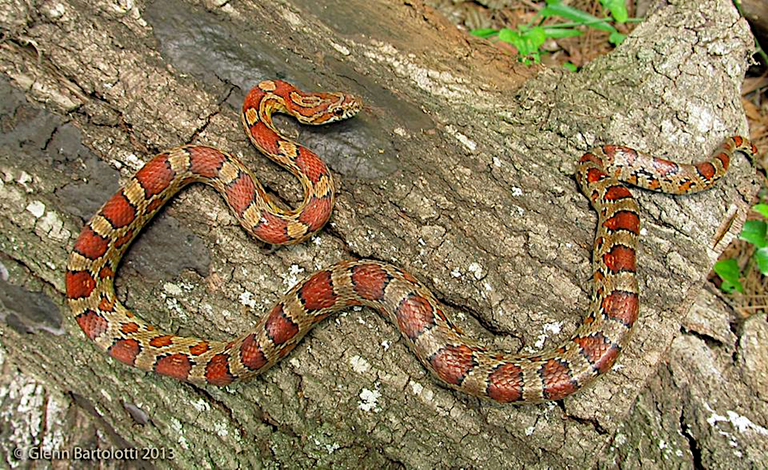
Image credit: Glenn Bartolotti. Used under CC 4.0 license. Usually, small snakes eat insects and spiders. Large snakes do not derive much nutrition from these small animals and are likely to consider them as appetizers, not the main course. One snake species that does eat insects and spiders is the corn snake.

As I looked for material on snakes that eat spiders, I came across something much more surprising: spiders that eat snakes. There are actually spiders that feast on snakes. This information is relatively new to the spider/snake (arachnologist/herpetologist) community. It seems that a considerable number of spider species engage in this activity, and amazingly, even more snake species are affected.
According to Smithsonian Magazine, upwards of 40 spider species have been observed catching and eating snakes. Upwards of 90 snake species have been observed in this unfavorable (for the snake) relationship. Keep in mind that there may be many occasions of this interaction that have not been observed, given the remote areas where snake and spider species live.
Australian Redback Spider

Image credit: Laurence Grayson from Suffolk, UK. Used under CC 2.0 license. According to an article in Science News, if you don't include its legs, the redback spider is only about the size of an M&M candy. Yet it can take down one of the most venomous snakes in the world. Although indigenous to Australia, the redback may now be found in New Zealand and throughout Southeast Asia.

The Australian redback is one of several kinds of widow spiders. The widows belong to the Theridiidae family. Spiders in the family are also known as comb-footed or cobweb spiders. The Theridiidae family of spiders is cosmopolitan, which means it has world-wide distribution, though the spider is not found in Antarctica. There are at least a hundred genera in this family. Most of these are harmless. However, harmless does not describe one genus in the family: Latrodectus.
There are 34 identified Latrodectus species. These include redbacks, black widows, brown widows and button spiders (South Africa). Redbacks, black widows, brown widows and button spiders all kill and eat snakes. It is said that the button spider can kill a snake 100 times larger than itself.
Female Inland Button Spider (Latrodectus Renivulvatus)
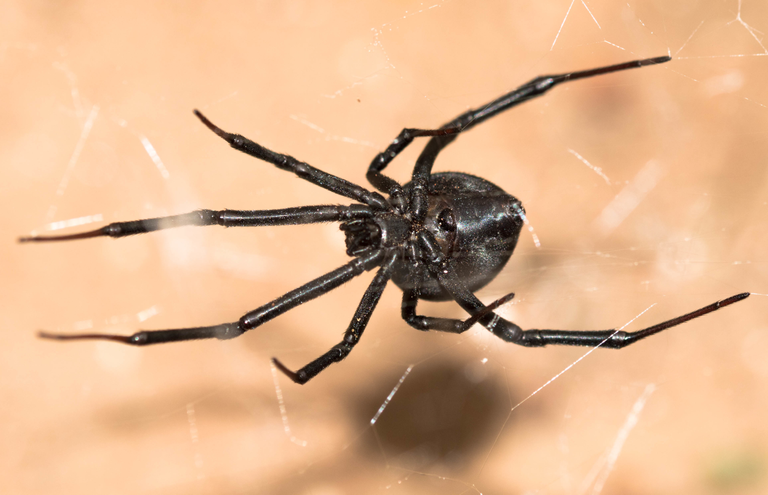
Image credit: RudiSteenkamp. Used under CC 4.0 license.
All spiders in the Latrodectus genus are venomous and are considered of 'medical significance'. This means, if you get bitten, seek medical attention right away. The best thing would be to catch the spider that bites you so that the doctor can properly assess the danger and treatment.
The good news is, these spiders are not interested in you. They are rather shy and will only mess with you if you mess with them, even accidentally. The one exception to this is a female that is guarding her eggs. Only female widows have large enough mandibles and carry enough venom to hurt most humans. Juveniles and males usually are not dangerous to humans.
Black Widow With Egg Sack
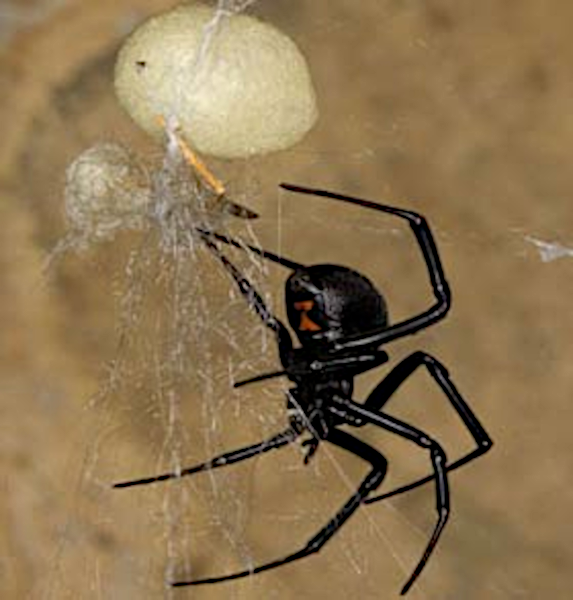
Image credit: Mark Chappell of University of California, Riverside. Used under CC 2.5 license
Other types of spiders that prey on snakes are tarantulas and orb-web spiders. Some tarantulas have a diet that consists exclusively of frogs and snakes. Unlike other snake-eating spiders, tarantulas do not ensare the snake with a web but actively hunt and kill.
Tarantula
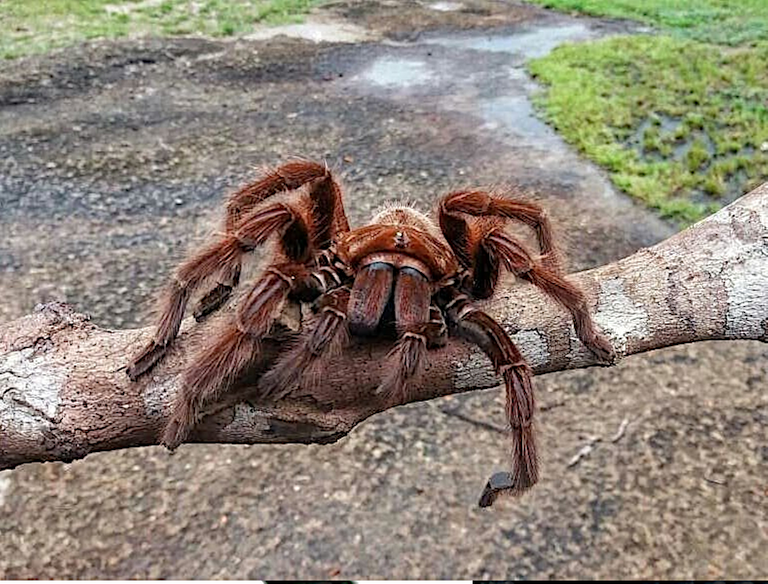
Image credit: @argeh, on #LIL. Public domain.
What was surprising to me was that many of the snake species attacked were venomous. Some venomous snakes that have fallen prey to spiders are: coral snakes, rattlers, palm-pitvipers and lanceheads. The more venomous the snake the longer it takes for that snake to succumb to the spider venom.
Palm Pit-Viper, Bothriechis nigroviridis
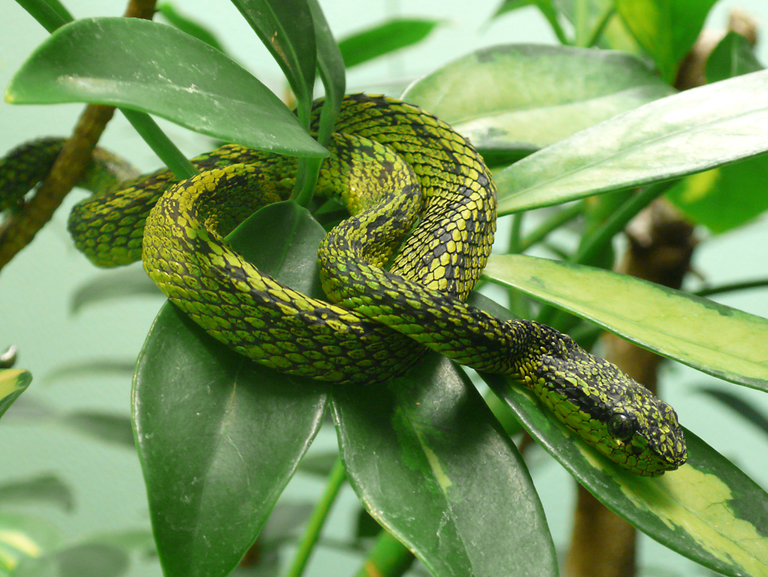
Image credit: TimVickers. Public domain.
In Australia, the redback spider has been observed killing and eating an Eastern Brown Snake, which is said to be the second most venomous snake in the world. This snake may be up to 30 times the size of the attacking spider.
Australian Juvenile Eastern Brown Snake
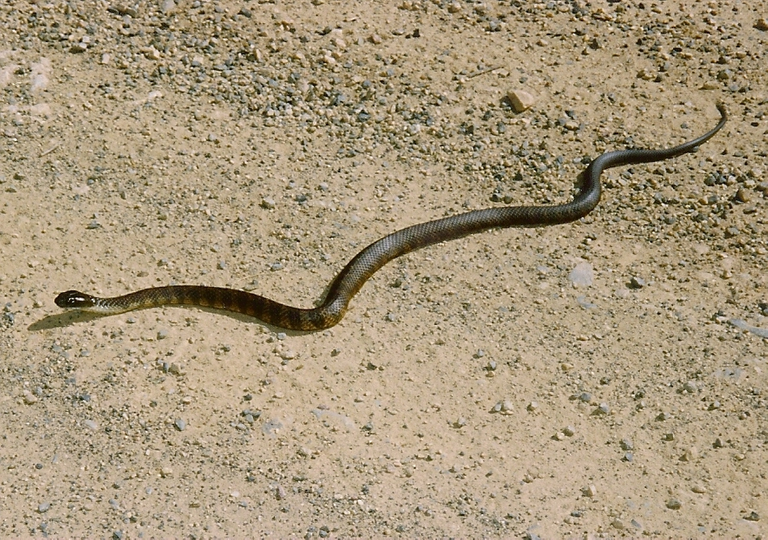
Image credit:Poyt448 Peter Woodard. Released into the public domain by the author. Juvenile Eastern Brown Snakes have stripes and adult snakes do not. However, both juvenile and adult snakes carry lethal venom.
An adult eastern brown snake can grow to seven feet. The article I read describes a spider eating a juvenile.
While Australia has a reputation for being home to venomous spiders, the North American black widow is actually a more prolific snake hunter. Half of the recorded arachnid on snake attacks came from North America. A third came from Australia.

I haven't forgotten the promise in the title to introduce readers to a vegetarian spider. While snakes are obligate carnivores, that is not true for spiders. There is at least one known spider that prefers plants to meat, and there are other spiders that eat plants, as well as meat. Most of the plant-eating spiders enjoy nectar.
As I discuss spider species here, please keep in mind that there have been 43,000 spider species identified in the world. It is estimated that this may only represent half of all species. There are so many yet to be discovered and/or identified.
Bagheera Kiplingi: Vegetarian Spider
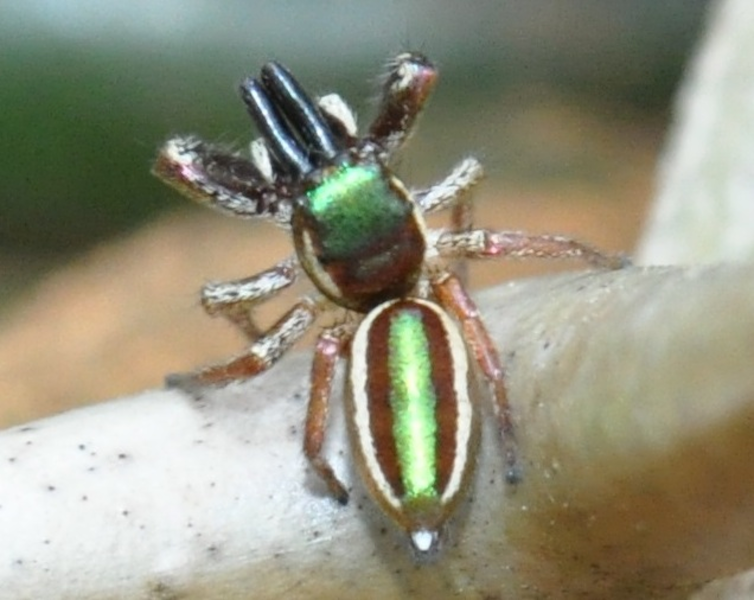
Image credit: Maximilian Paradiz. Used under CC 2.0 license. This spider is the only known (discovered so far) spider that feeds almost exclusively on plants.
The Bagheera kipling was discovered in Costa Rica in 2001. The animal spends its entire life on acacia plants. In order to do so, it must avoid ants that also live on the acacia. The ants have a mutualistic relationship with the plant. They feed off it and protect it from herbivores, such as Bagheera kipling.
Ants That Live on the Acacia, Pseudomyrmex ferruginea
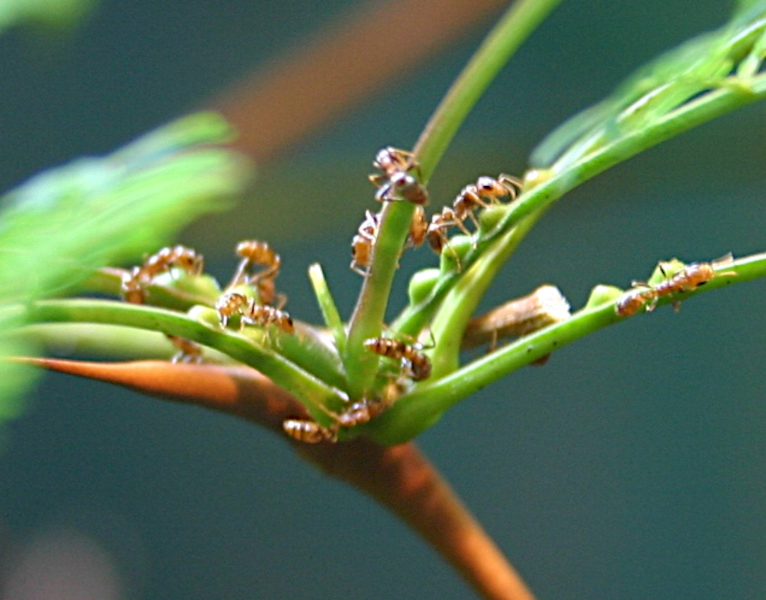
Image credit: Ryan Somma. Used under CC 2.0 license
Most of the plant-eating spiders enjoy nectar. Some of the nectar-craving spiders have taken on the appearance of an ant in order to elude detection.
Peckhamia, Nectar-Eating Spider That Looks Like an Ant
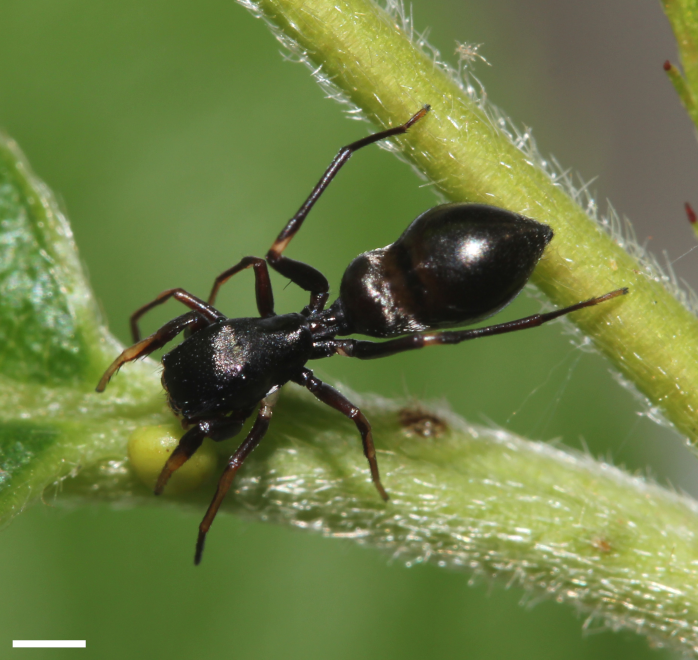
Image credit: David Hill. Used under CC 2.0 license.
While this species of spider competes with ants for nectar, the spider has been observed also eating ants. However, when competing for nectar, the spiders are cautious. They wait until the coast is clear. They are able to avoid the ants because the spiders have excellent eyesight.

Conclusion
This blog wouldn't exist without the STEMsocial community. It was information I read there that sent me off on a minor research project. And, the images in the blog would not have been as rich without #LIL, an image resource associated with the LMAC community.
I find this subject fascinating. Most people are afraid of snakes and spiders (I am, if they get too close). The best way to handle fear I think is through information. Plus, reading about these animals reminds me of the wonderful adaptability of life. Each species mentioned in this blog has evolved to survive in a particular niche. Each species serves an important function.
The more we understand, I believe, the more we will respect the multitudinous forms of life that share this planet with us. I hope my readers have enjoyed this essay as much as I enjoyed writing it.
Everyone be well, be safe, be as happy as life allows.



Sources
Illustration not already credited in blog
Spider Accent: @muelli on #LIL
Snake Accent: @agmoore on #LIL
Spider GIF: @agmoore, using @muelli's spider
This post was inspired by two two blogs that appeared on STEMsocial: Datos relevantes sobre arañas enanas del género Oecobius y la especie Oecobius navus by @abneagro, and Reproductive Habits in Snakes, by @gentleshaid.
Selected Research Sources
1https://www.sciencenews.org/article/spiders-eat-snakes-biology
2https://www.almanac.com/garter-snakes-gardeners-friend
3https://www.livescience.com/spiders-prey-on-snakes.html
4https://www.snopes.com/fact-check/snake-intake/
5https://faunafacts.com/snakes/do-snakes-eat-spiders/
6https://www.billabongsanctuary.com.au/eastern-brown-snake/
7https://www.livescience.com/spiders-prey-on-snakes.html
8https://entomology.wsu.edu/outreach/bug-info/black-widow/
9https://www.farmonline.com.au/story/4670080/brown-snakes-get-more-deadly-with-age/
10https://www.dailymail.co.uk/sciencetech/article-9726801/Spiders-eating-snakes-planet-shocking-study-says.html
11https://australian.museum/learn/animals/spiders/redback-spider/
12https://www.studyfinds.org/spiders-eat-snakes/
13https://bioone.org/journals/the-journal-of-arachnology/volume-49/issue-1/JoA-S-20-050/Spiders-Arachnida-Araneae-feeding-on-snakes-Reptilia-Squamata/10.1636/JoA-S-20-050.full
14https://www.sciencedirect.com/topics/pharmacology-toxicology-and-pharmaceutical-science/latrodectus
15https://www.smithsonianmag.com/smart-news/these-40-spiders-kill-and-eat-snakes-180978380/
16https://www.sciencealert.com/a-tarantula-mauled-this-snake-to-death-and-scientists-have-never-seen-anything-like-it
17https://www.australiangeographic.com.au/topics/wildlife/2015/05/what-to-do-if-you-find-a-spider/
18https://srelherp.uga.edu/snakes/cemcoc.htm
19https://petkeen.com/snakes-that-dont-eat-mice/
20https://www.livescience.com/5759-rare-vegetarian-spider-discovered.html
21https://cisr.ucr.edu/invasive-species/brown-widow-spider
22https://peckhamia.com/peckhamia/PECKHAMIA_178.1.pdf
23https://www.livescience.com/54053-photos-plant-eating-spiders.html
24https://news.arizona.edu/story/herbivory-discovered-in-a-spider
25https://www.livescience.com/21818-spiders-scoprions-exhibit.html
26https://www.sciencenewsforstudents.org/article/spiders-catch-eat-surprisingly-big-snakes
27https://www.stlzoo.org/animals/abouttheanimals/invertebrates/spidersandscorpions/blackwidow
28https://www.sciencedirect.com/topics/pharmacology-toxicology-and-pharmaceutical-science/latrodectus-hesperus
29https://www.onhealth.com/content/1/bites_dangerous_spider_treatment
30https://presswire18.com/button-spider-these-african-spiders-the-worlds-most-poisonous-make-snakes-prey-in-a-jiffy/
31https://www.sciencedirect.com/topics/agricultural-and-biological-sciences/theridiidae
32https://www.canr.msu.edu/resources/comb-footed-spiders
33https://www.worldatlas.com/articles/where-do-redback-spiders-live.html
34https://peteducate.com/do-snakes-eat-insects/
35https://rawznaturalpetfood.com/obligate-carnivore-cats/



